What are the latest developments in the research of MXene by the domestic research group? Look at these twelve papers!
QQ Academic Group: 1092348845
Detailed
MXene is a type of metal carbide and metal nitride material with a two-dimensional layered structure. It is a graphene-like structure obtained by MAX phase processing. The specific molecular formula of the MAX phase is Mn+1AXn (n = 1, 2 or 3), where M refers to the transition metals of the previous groups, such as Sc, Ti, Zr, V, Nb, Cr or Mo; A usually represents the first Three main group and fourth main group chemical elements; X refers to C or N element. Since M-X has a strong bond energy and A has a more active chemical activity, A can be removed from the MAX phase by etching to obtain a graphene-like 2D structure-MXene. Due to the unique properties of MXene, it has been widely used in catalysts, ion sieving, photothermal conversion, field effect transistors, topological insulators, and hydrogen evolution reactions. In recent years, significant achievements have been made in the fields of MAX-phase structural materials and MXene energy materials in China. With the development of synthesis technology and the in-depth exploration of multidisciplinary cross-discipline, more and more domestic materials research groups have devoted themselves to this type of research. Research on novel materials.
1. Jun Yan from Harbin Engineering University Adv. Funct. Mater.: Three-dimensional porous MXene/graphene antioxidant structure for in-situ zinc template preparation of high-performance supercapacitors
Two-dimensional transition metal carbides and nitrides (also known as MXene) endow MXene with a lot of fascinating properties due to its unique structure and tunable surface chemistry. MXene has huge application potential in the field of energy storage. However, similar to other two-dimensional materials, due to strong van der Waals forces, adjacent MXene interlayers inevitably undergo agglomeration and face-to-face re-stacking, which severely causes severe loss of electrochemically active sites and greatly limits the electrolyte ions. Therefore, dense MXene films generally exhibit low specific capacitance (100-300 F g-1) and poor rate performance, which still needs further improvement. In addition, MXene generally tends to gradually degrade in moist air, water, or under high temperature, hydrothermal and lytic heat conditions. In order to solve the above-mentioned huge challenges. The research group of Professor Jun Yan from Harbin Engineering University demonstrated an efficient and rapid strategy. Through the self-assembly method, metal zinc powder is used as an in-situ sacrificial template at room temperature, and then freeze-dried, thereby effectively inhibiting the possible occurrence of MXene. The surface is oxidized, and a 3D porous antioxidant MXene/graphene (PMG) structure is constructed. MXene and RGO nanosheets are cross-linked to form a three-dimensional porous structure, which is induced by Zn2+ as a cross-linking agent and zinc powder as an in-situ sacrificial template and reducing agent. This unique structure endows the 3D PMG composite with super electrochemical performance as a supercapacitor electrode, such as an intriguing specific capacitance (393 F g-1 at 2 mV s-1) and unparalleled rate performance (10 V s-1). -1 is 32.7%), and impressive cycle stability. In addition, due to the removal of oxygen-containing terminal groups and the cross-linking between MXene and graphene nanosheets as a shielding agent, 3D PMG composites also show significant oxidation resistance.
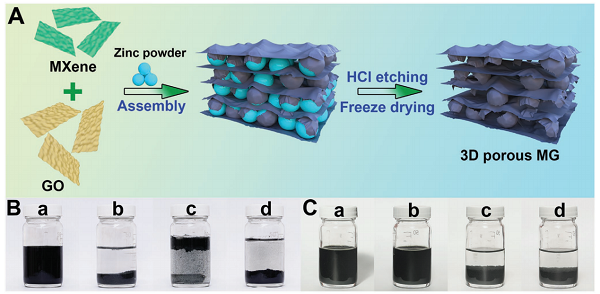
References: Yang X, Wang Q, Zhu K, et al. 3D Porous Oxidation-Resistant MXene/Graphene Architectures Induced by In Situ Zinc Template toward High-Performance Supercapacitors[J]. Advanced Functional Materials, 2021: 2101087.
2. Peng Qiuming Adv. Funct. Mater. from Yanshan University: Lithium MXene derivative framework for wide-temperature lithium metal anode
Lithium has an extremely low redox overpotential (-3.04 V relative to a standard hydrogen electrode) and the highest theoretical specific capacity (3860 mAh g-1, which is more than 10 times that of graphite). It is a promising Li-O2 and The electrode material of Li-S battery, unfortunately, due to uncontrolled dendrite growth and infinite volume expansion, leading to short circuits and rupture of the SEI film. Professor Peng Qiuming of Yanshan University and others used the cross-linked network structure of MXene to provide fast electron/ion transmission channels and at the same time serve as a framework for uniform Li deposition. In the 3D framework, super photophilic materials can be introduced to transfer Li deposition to Keep away from the separator/negative electrode interface to prohibit the formation of Li dendrites. In addition, considering that temperature will significantly affect the characteristics of metal lithium batteries. For example, high temperature will easily volatilize the electrolyte and reduce battery cycle performance, while low temperature will reduce the mobility of lithium ions and accelerate the growth of dendrites. In this paper, a new type of 3D LiTiO2-Li3N-C hybrid anode prepared by the reaction of molten Li and MXene-derived TiO2/N-doped carbon has been realized for the first time for a stable lithium metal battery. The team proved that LiTiO2-Li3N-C is a hybrid negative electrode with a volume expansion close to zero during the stripping/plating process. At the same time, the Li3N formed during the melt manufacturing process acts as a super-photophilic intermediate phase, guiding Li deposition away from the separator/negative electrode interface. In addition, when the current density of LiTiO2-Li3N-C is 1 mA cm-2 at 25°C, it can provide 2000 hours of continuous electroplating/stripping cycle life in a symmetrical cell. More attractively, even at a high current density of 10 mA cm-2, the symmetrical battery can be cycled at -10°C and 50°C for 34 hours and 500 hours, respectively.

References: Wang J, Yang M, Zou G, et al. Lithiation MXene Derivative Skeletons for Wide-Temperature Lithium Metal Anodes[J]. Advanced Functional Materials, 2021: 2101180.
3. Fujian Normal University Li Xiaoju Adv. Mater.: Ion covalent organic nanosheets with electrostatic adsorption and catalysis realized on MXene, used as separators for lithium-sulfur batteries
Lithium-sulfur battery (Li-S) is considered to be an attractive energy storage system due to its high energy density and low cost. However, it has the most complex problems such as the shuttle effect of soluble polysulfides, which can lead to The capacity decays fast, the self-discharge is serious, the energy efficiency is low, and the cycle stability is poor. Using nanostructured materials as a sulfur host is a common method to alleviate the shuttle of polysulfides. Although great progress has been made in the design and synthesis of sulfur composite cathodes, it is still a huge challenge to achieve high energy density and ultra-long life under high sulfur content, high sulfur loading, and high speed. MXenes is a type of two-dimensional transition metal carbides/carbonitrides. Due to its high conductivity, amphiphilic and catalytic effects on polysulfides, it has broad application prospects in lithium-sulfur batteries. However, an insurmountable obstacle in MXene nanosheets is the re-stacking caused by van der Waals attraction and hydrogen bond interaction, which leads to a large loss of specific surface area and difficulty in obtaining high concentrations of polysulfides. One of the effective solutions is to combine MXenes with porous materials to form composite materials. Two-dimensional covalent organic frameworks (COFs) are an attractive class of porous materials composed of strong covalent bonds and periodic structural units. The unique structure of COFs brings huge advantages to the adsorption and mass transfer of polysulfides. However, so far there is no report on the use of MXene and ionic polymer composite materials for Li-S batteries. The research group of Professor Li Xiaoju from Fujian Normal University proposed a new strategy to modify polypropylene diaphragms by using the electrostatic adsorption and catalysis of polysulfides. The guanidine-based covalent organic nanosheets (iCON) on the surface of Ti3C2 are used as the coating of the PP separator. The synergistic effect of Ti3C2 and iCON provides a new platform for inhibiting the shuttle effect of polysulfides, accelerating the redox kinetics of sulfur species, and promoting the efficient conversion of intercepted polysulfides. The functional separator imparts excellent electrochemical performance to the carbon nanotube/sulfur cathode. At 2°C, the average capacity attenuation per cycle within 2000 cycles is as low as 0.006%. When the sulfur content is 90 wt% and the sulfur content is 7.6 mg cm-2, the membrane can still effectively separate; the reversible capacity, area capacity and volume capacity at 0.1 C reach 1186 mA hg-1, 9.01 mA h cm-2 and 1201 mA h cm-3. This work provides a promising method for reforming the diaphragm for the development of high-performance Li-S batteries.

References: Li P, Lv H, Li Z, et al. The Electrostatic Attraction and Catalytic Effect Enabled by Ionic-Covalent Organic Nanosheets on MXene for Separator Modification of Lithium-Sulfur Batteries[J]. Advanced Materials, 2021: 2007803.
4. Xiao Zhubing Small, Henan University: CNTs grown on MXene induced by Ostwald maturation between layers are used for lithium-sulfur batteries
Transition metal carbides, carbonitrides and nitrides (MXenes) have extremely high metal conductivity, hydrophilicity, catalytic activity and excellent mechanical properties, making them become energy storage electrode materials or electrocatalysts such as water decomposition and N2 fixation Rising stars in the field. Despite these advantages, layered MXenes tend to restack themselves due to hydrogen bonds or van der Waals interactions between the layers, which results in a substantial reduction in surface area and hinders ion transfer and electrolyte penetration. In recent years, the hybridization of MXene with some inorganic materials is considered an effective strategy. MXene substrate can inhibit the agglomeration of attached particles and buffer the mechanical stress imposed on them. The attached particles act as a wedge, reducing the re-stacking of adjacent MXene layers, thereby maximizing the exposure of active sites and allowing ion transfer It is smoother and allows electrolyte to penetrate. However, most of the attached particles used in the reported solutions are metal oxides and sulfides, which usually have poor Li+ diffusivity and conductivity, which brings some adverse effects: 1) These low-conductivity particles are incompatible with After the hybridization of MXenes, heterogeneous grain boundaries and gap junctions are inevitably formed, which increases the interlayer charge transfer resistance of the MXene layer, thereby hindering the electron transfer along the vertical direction. 2) Due to the harsh preparation conditions, most of the MXenes in the hybrid product exhibit a higher degree of oxidation than the Mn+1XnTx precursor, which destroys the special properties such as metal conductivity attached to its structure. Therefore, it is of great significance to explore highly conductive inorganic-nano-MXenes hybrid materials with high integrity, rich active sites, rich and well-distributed nanopores. The research group of Professor Xiao Zhubing of Henan University reported that the in-situ Ti3C2Tx MXene-carbon nanotubes (Ti3C2Tx-CNTs) hybrids were generated by the low-temperature autocatalytic growth of CNTs on Ti3C2Tx nanosheets without adding any catalyst precursors.化物. Combining the results of spectroscopic studies and theoretical calculations, it is confirmed that the Ti3C2Tx nano-network structure induced by Ostwald maturation in the layer helps the ultrafine metal Ti catalyst to be uniformly precipitated on Ti3C2Tx, thereby forming high integrity in-situ CNTs on the Ti3C2Tx surface. Ti3C2Tx-CNTs hybrid material has the advantages of affinity electrolyte penetration, barrier-free three-dimensional Li+/e transport, and abundant electroactive sites, which proves that Ti3C2Tx-CNTs hybrid is a high-load lithium-sulfur battery to accommodate sulfur and regulate more Ideal 3D scaffold for sulfide conversion.
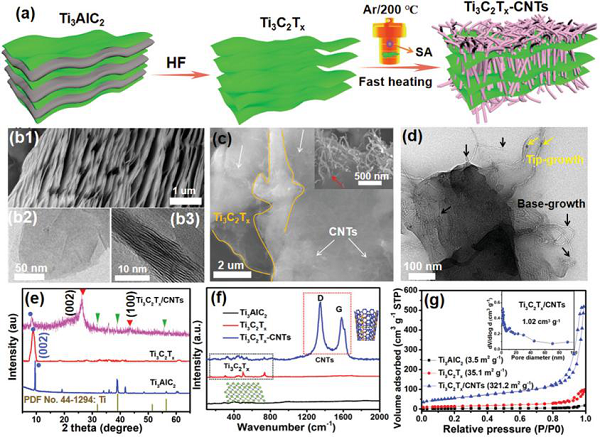
Reference: Xu M, Liang L, Qi J, et al. Intralayered Ostwald Ripening-Induced Self-Catalyzed Growth of CNTs on MXene for Robust Lithium-Sulfur Batteries[J]. Small, 2021: 2007446.
5. Jida Han Wei and Shen Guozhen, Institute of Semiconductors, Chinese Academy of Sciences Adv. Funct. Mater.: Controllable assembly of MXene nanosheets as electrodes and active layers for high-performance electronic skin
MXene has excellent electrical conductivity, mechanical flexibility and water dispersibility, rich chemical composition, adjustable surface termination and controllable preparation process, and is widely used in flexible electronic products. The application of electronic skins with high sensitivity, portability and foldability in artificial intelligence, human-computer interaction, health monitoring, soft robots and disease detection has received great attention. The flexible pressure sensor is generally composed of a flexible substrate, an active layer and conductive electrodes. The basic requirements for the development of this sensor are considerable bending strain capacity, high sensitivity, low drive voltage, fast response time and excellent stability. The structure and morphology of the active layer are considered to be the key factors to improve the pressure-sensitive response of flexible devices. This electrode must be compatible with the sensing film during the bending cycle and maintain its high conductivity. Professor Wei Han of Jilin University and the team of Guozhen Shen from the Institute of Semiconductors of the Chinese Academy of Sciences successfully fabricated a high-performance flexible pressure sensor based on MXene/PAN composite film with uniform Ti3C2Tx MXene electrodes. This flexible device has excellent pressure sensing performance and stability against mechanical bending. It also has a low detection limit of 1.5Pa and a fast response time of 30 ms. The sensitivity of this sensor is ≈2-20 times higher than similar sensors using traditional Ni, Cu, Au or Ag electrodes. In addition, the flexible pressure sensor based on MXene@PAN we made successfully detected human life activities such as pulses and sound signals, confirming its broad application prospects.
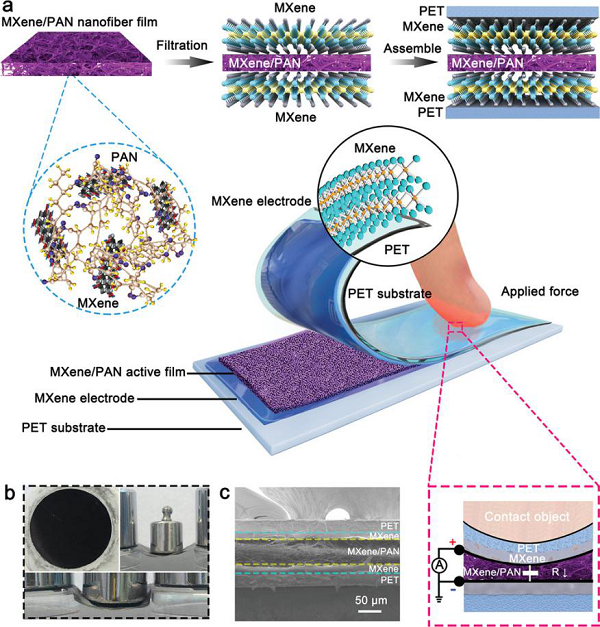
References: Fu X, Wang L, Zhao L, et al. Controlled Assembly of MXene Nanosheets as an Electrode and Active Layer for High-Performance Electronic Skin[J]. Advanced Functional Materials, 2021: 2010533.
6. Wu Mingbo, China University of Petroleum Adv. Funct. Mater.: Improve pseudocapacitance and high-load lithium/sodium storage by bonding polyoxometalate nanoparticles on MXene nanosheets
Hybrid supercapacitors combine the advantages of metal ion batteries and supercapacitors, and represent promising power sources for many current and emerging applications. Under normal circumstances, hybrid supercapacitors use the anode of a lithium-ion battery or sodium-ion battery as an energy source, and the cathode of a supercapacitor as an energy storage device. Since the anode and the cathode involve different working mechanisms, the key to promoting the practical performance of hybrid supercapacitors is to coordinate these two different electrodes reasonably. The battery type negative electrode uses a slow ion diffusion process for energy storage, while the capacitive type positive electrode stores charge through rapid surface adsorption/desorption. To fully tap the potential of hybrid supercapacitors, the imbalance between these two electrodes must be resolved. Kinetic issues. Therefore, there is an urgent need for battery-type electrode materials that have multiple electrons participating in the redox reaction and can quickly transfer lithium/sodium ions. To this end, a feasible solution is to form a stable connection between the redox active sites of lithium/sodium storage and the conductive substrate that promotes charge transfer. The research group of Professor Mingbo Wu from China University of Petroleum reported that through rational use of their interactions, dense and uniformly dispersed Mo and Fe-based POM (MF POM) nanoparticles were grown in situ on MXene (Ti3C2X) nanosheets, thereby achieving high speed Capacity of lithium/sodium storage. Ti3C2X nanosheets can realize effective electron transfer due to their metal conductivity, while POM nanoparticles prohibit their strong re-stacking tendency. The synergy between these two components enables lithium/sodium energy storage to exhibit high specific capacity, high magnification and excellent stability even under high-quality loads. Based on the electrode material, lithium ion capacitors (LIC) and sodium ion capacitors (SIC) are manufactured, which have high energy density, high power capability and excellent cycle stability.
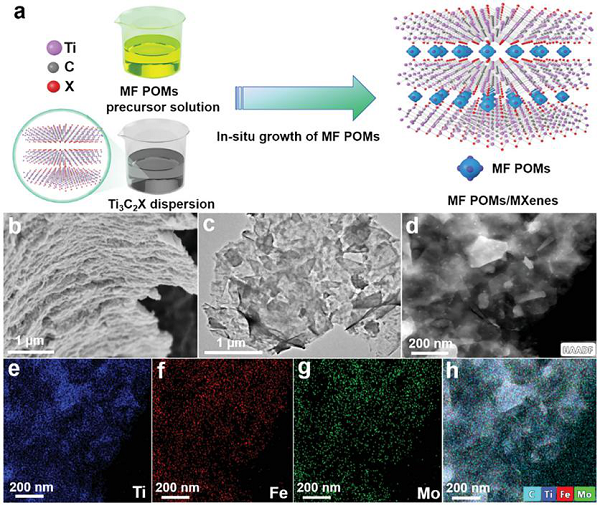
References: Chao H, Qin H, Zhang M, et al. Boosting the Pseudocapacitive and High Mass-Loaded Lithium/Sodium Storage through Bonding Polyoxometalate Nanoparticles on MXene Nanosheets[J]. Advanced Functional Materials, 2021: 2007636.
7. Han Suting Adv. Funct. Mater. of Shenzhen University: MXene-ZnO memristor for multi-modal sensor calculation
The development of the Internet of Things and artificial intelligence has induced the rapid growth of sensor nodes, resulting in a large amount of unstructured redundant raw data. In traditional designs, analog sensor data is first converted into digital data through analog-to-digital conversion, and then stored in a memory unit. The calculation task is further completed by transmitting digital data between the memory and the local computing unit. The separate architecture of the sensor, memory, and data processing unit leads to data acquisition delay and relatively high power consumption. Therefore, some people propose to directly process information in-sensor calculations through a single sensor or multiple connected sensors to improve the energy, area, and time efficiency of the artificial intelligence system. Current research is mainly focused on single sensory processing, such as hearing, vision, touch, smell and so on. The human perception system can simultaneously perceive and process complex environments and process different types of information. Therefore, there is an urgent need to explore a smart device with light and proton-related signal processing functions to imitate the adaptive behavior of the human eye in different environments. MXene is a new family of two-dimensional transition metal carbonitrides, carbides and nitrides. Due to its solution processability and intriguing physical and chemical properties, it has become a promising two-dimensional in many fields such as energy conversion and storage. material. The research group of Professor Han Suting of Shenzhen University demonstrated the calculation of multi-modal internal sensors based on flexible membrane resistance units. Each unit is composed of MXene nanosheets/ZnO nanoparticles (NPs) heterogeneously. The combination of metal MXene and semiconductor ZnO NPs can ensure the proper resistance state of the memristor. In addition, Ti3C2 terminated with OH bond has high hydrophilicity and can be combined with photoactive ZnO NPs. The resistance switching characteristics can be modulated by changing light intensity or humidity. The proton/photon-mediated plasticity allows the memory resistance crossbar to light/ Proton sensing is combined with neuromorphic computing. In sensor calculations, MXene-ZnO memristors are used as filters to preprocess information and synapses to achieve a weight update process with different humidity adaptability. Multi-modal calculations within the sensor provide the potential to reduce the potential circuit complexity of traditional neuromorphic vision systems and contribute to the development of intelligence at the device level.
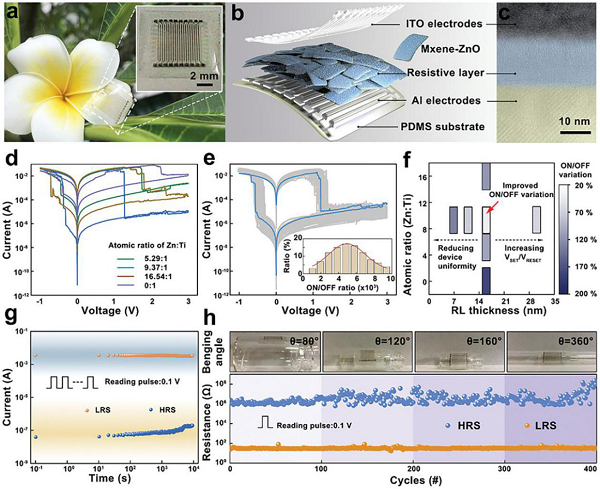
Reference: Wang, Yan, et al. MXene-ZnO Memristor for Multimodal In-Sensor Computing. Advanced Functional Materials (2021): 2100144.
8. Beijing University of Chemical Technology Wan Pengbo ACS Nano: Healable, degradable, conductive MXene nanocomposite hydrogel is used for multifunctional epidermal sensors
As a next-generation flexible epidermal sensor material, conductive hydrogel converts physiological activity signals into detectable electronic signals by virtue of its good flexibility and high sensitivity for information acquisition, which has attracted more and more attention. However, the existing conductive hydrogel has poor mechanical properties and is inevitably damaged during the stretching process, which seriously hinders its practical application in flexible skin sensors. At the same time, compared with traditional hydrogel-based sensors to monitor various human movements, the detection of electrophysiological signals such as electromyography (EMG) and electrocardiogram (ECG) signals is of great significance to the diagnosis and treatment of heart and muscle-related diseases. Therefore, there is an urgent need to develop conductive hydrogel-based epidermal sensors with autonomous self-healing capabilities and environmental degradation capabilities to detect human physiological and electrophysiological signals. As a transition metal carbide, nitride or carbonitride, MXenes has broad application prospects in the fields of electromagnetic interference shielding, catalysts and electrochemical energy storage. With abundant surface functional groups (-OH, -F, -O, etc.), large specific surface area and high conductivity, it is expected to improve the mechanical properties and conductivity of hydrogel-based epidermal sensors. Researcher Wan Pengbo of Beijing University of Chemical Technology proposed a synthesis strategy for a multifunctional epidermal sensor based on a highly stretchable, self-healing, degradable, and biocompatible nanocomposite hydrogel. The composite hydrogel is manufactured by conformally coating the MXene (Ti3C2Tx) network on a hydrogel polymer network composed of polyacrylic acid and amorphous calcium carbonate. The epidermal sensor can be used to sensitively detect human movement, has a fast response time (20ms), and can be used as an electronic skin for wireless monitoring of electrophysiological signals (such as electromyogram and electrocardiogram signals). At the same time, the multifunctional epidermal sensor can be degraded in a phosphate buffered saline solution without causing pollution to the environment. Research work in this field provides clues for the manufacture of conductive hydrogel skin sensors that are healing, degradable, and sensitive to electrophysiological signals. These sensors have potential applications in human-computer interaction, health diagnosis, and intelligent robotic prosthetic devices. .
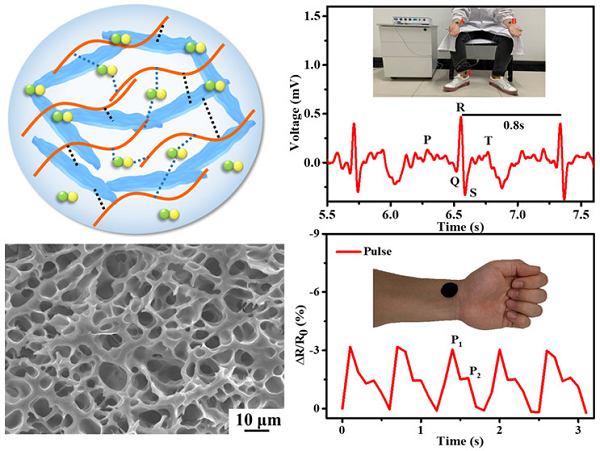
References: LI, Xiaobin, et al. Healable, Degradable, and Conductive MXene Nanocomposite Hydrogel for Multifunctional Epidermal Sensors. ACS nano, 2021.
9. Jida Han Wei and Wang Lili of the Institute of Semiconductors of Chinese Science and Technology ACS Nano: Carbon-reinforced Nb2CTx MXene/MoS2 nanosheets as high-rate and high-capacity anodes for sodium-ion batteries
Among metal sulfides, MoS2 has attracted much attention due to its high energy density and layered structure. The interlayer van der Waals attractive force of MoS2 is relatively weak, so it has a higher specific surface area and a larger ion intercalation interval. MoS2 has a high theoretical capacity and excellent performance in lithium ion batteries, but due to the larger sodium ion radius (compared with lithium ion radius), the volume expansion caused by sodium insertion is more severe, so it is used in sodium ion batteries There are still problems such as low capacity and poor cycle stability.
Compared with MoS2, Nb2CTx has a lower sodium diffusion barrier, excellent electrical conductivity and more surface functional groups. Therefore, Nb2CTx is a potential negative electrode material for sodium ion batteries. Professor Han Wei from Jilin University and Professor Wang Lili from the Institute of Semiconductors of the Chinese Academy of Sciences and others developed carbon-coated Nb2CTx MXene framework MoS2 nanosheets (Nb2CTx@MoS2@C) and constructed a solid three-dimensional cross-linked structure. In such a design, the highly conductive Nb2CTx MXene nanosheets can prevent the re-stacking of MoS2 sheets and provide effective channels for charge transfer and diffusion. In addition, the layered carbon coating has a certain volume elasticity and excellent electrical conductivity, which ensures the insertion of sodium ions, which is not only conducive to rapid dynamics, but also conducive to long-term stability. Nb2CTx@MoS2@C negative electrode can provide an ultra-high reversible capacity of 530 mA h g-1 under the condition of 0.1 A g-1 after 200 cycles, and under the condition of 1.0 A g-1, it can be used for 2000 times In the cycle, the capacity is 403 mA h g-1, and the degradation rate per cycle is only 0.01%, which has a very long cycle stability. In addition, in terms of rate performance, the capacity retention rate of this negative electrode from 0.1 to 1 A g-1 is about 88.4%. The most important thing is that the Nb2CTx@MoS2@C negative electrode can achieve rapid charge and discharge at a current density of 20 or even 40 A g-1, with capacities of 340 and 260 mAh g-1, respectively, which will increase the number of sodium-ion batteries in practical applications .
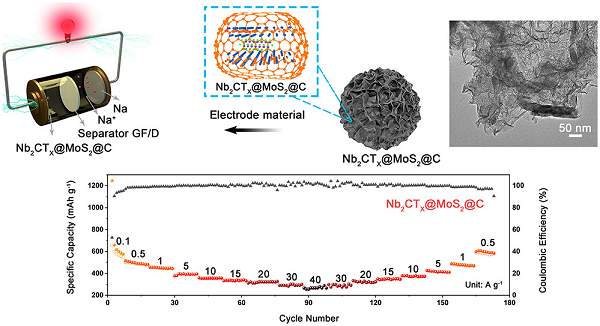
References: YUAN, Zeyu, et al. Carbon-Reinforced Nb2CTx MXene/MoS2 Nanosheets as a Superior Rate and High-Capacity Anode for Sodium-Ion Batteries. ACS nano, 2021.
10. Lv Shaoyu, Lanzhou University, ACS Appl. Mater. Interfaces: Super-stretched MXene composite hydrogel as a two-way stress-responsive thixotropic sensor
The development and application of biological intelligent sensing technology has penetrated into our lives. However, problems such as low mechanical properties, inflexible signal transmission, and insensitive signal output limit the development of biosensors. In order to solve these problems, the hydrogel-based biosensor has been designed and developed due to its excellent soft stretch performance, special conductive framework and complex 3D ion channels. Because of its unique high electron mobility and inter-chip energy storage characteristics, MXene expands the development and application prospects of conductive hydrogels as biosensors. MXene nanocomposite organic hydrogel can perform 350% strain sensing at low temperatures. However, the previously reported MXene composite conductive hydrogel, due to its insufficient mechanical properties, causes the sensing tensile strain to not exceed 1000%. After large strain, the hydrogel cannot recover or maintain its original shape, even if it has a large strain sensing capability. It is also impossible to realize dynamic sensing under small local concentrated stress stimulation, which limits the application of MXene composite hydrogel as a flexible sensor. Professor Lu Shaoyu’s research group from Lanzhou University has developed a super-stretched MXene composite conductive hydrogel with a tensile strain of more than 1800%. The hydrogel is used as a flexible wearable sensor to detect human motion signals in real time. The sensor achieves high sensitivity and can distinguish human body movements in multiple directions, such as joint bending, throat vocalization, swallowing, and pulse beating. In addition, it is observed that the MXene composite hydrogel has rapid resilience after unloading the reverse compressive stress, and can quickly generate a specific current response in the low pressure area without leaving any traces. This thixotropic sensor realizes a rapid response to two-way stress, and has huge application prospects in the fields of human motion detection and national defense information encryption.
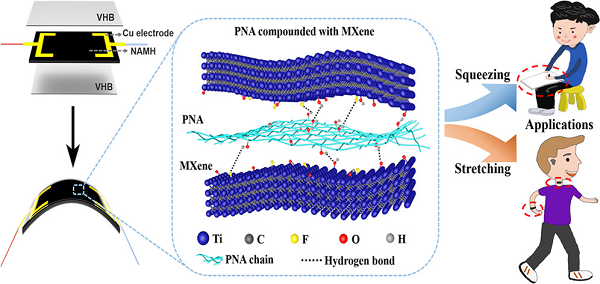
References: CHEN, Siqi, et al. Superstretching MXene Composite Hydrogel as a Bidirectional Stress Response Thixotropic Sensor. ACS Applied Materials & Interfaces, 2021.
11. ACS Appl. Mater. Interfaces: Hydroxyl promoted nitrogen reduction reaction: the important role of surface hydrogen in functionalized MXenes
Ammonia (NH3) is an important industrial raw material widely used in the production of fertilizers, refrigerants and other chemicals. Electrochemical Nitrogen Reduction Reaction (NRR) is a promising technology to replace the Haber-Bosch process (HBP). Through the reaction of N2 and H2O, green NH3 can be generated at room temperature. The core of this process is to find an effective catalyst that can improve the activity and selectivity of NRR, which is still a huge challenge. 2D MXenes have been extensively studied for electrocatalytic NRR due to the advantages of exposed active sites and high conductivity. At the same time, some theoretical studies have shown that MXenes without terminal groups can effectively activate N2 and catalyze NRR. However, the exposed surface of MXenes is very active, because exposed metal atoms tend to terminate with changes in applied potential and pH. Therefore, the previous NRR research based on naked MXenes is debatable. It is necessary to re-study the functionalized MXenes and explore new reaction mechanisms to clarify the actual catalytic process and track the missing chemical components. Professor Thomas Frauenheim of the University of Bremen in Germany and Professor Liangzhi Kou of the Queensland University of Technology in Australia studied several MXenes (Ti2C, V2C, Cr2C, Zr2C, Nb2C, Mo2C, Hf2C, Ta2C) Priority structure under NRR operating conditions. The results show that OH, as a new surface hydroxylation mechanism, plays an important role in NRR chemical regulation. In the widely accepted NRR mechanism, only protons participate in the reaction Differently, the hydrogen (H) atoms of the surface hydroxyl groups can be captured by the intermediate and participate in the NRR reaction, while the remaining H vacancies can then be self-repaired by protons under the applied potential. The synergistic effect of surface hydroxylation can effectively increase NRR, and Mo2C(OH)2 stands out with a limit potential of -0.62 V and the highest selectivity. In addition, a new scale relationship based on the H vacancy energy was established to clarify the possibility of structure-activity regulation. The study not only explained the important role of surface OH functionalization in evaluating the performance of NRR, but also provided new insights for promoting the sustainable production of NH3.
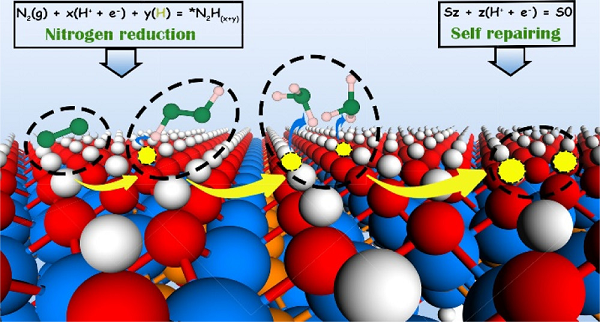
References: LV, Xingshuai; KOU, Liangzhi; FRAUENHEIM, Thomas. Hydroxyl-Boosted Nitrogen Reduction Reaction: The Essential Role of Surface Hydrogen in Functionalized MXenes. ACS Applied Materials & Interfaces, 2021.
12. Wang Xinhua of Zhejiang University and ACS Appl. Mater. Interfaces in Liuhai Town of Guangxi University: The combination of V2C and Ti3C2 MXenes improves the hydrogen storage performance of MgH2
Magnesium hydroxide (MgH2) has a high hydrogen density (7.6 wt %) and good reversibility, making it an ideal hydrogen storage material. However, its high thermal stability and slow kinetics severely limit its practical application. Two-dimensional transition metal carbides/nitrides (MXenes) and their derivatives also have a positive impact on hydrogen storage materials due to their special physical and chemical properties. Professor Wang Xinhua of Zhejiang University and Assistant Professor Liu Haizhen of Guangxi University synthesized 2D vanadium carbide (V2C) and titanium carbide (Ti3C2) MXenes by stripping V2AlC or Ti3AlC2, and introduced them into magnesium hydroxide (MgH2) to adjust MgH2 The hydrogen desorption/absorption performance. The prepared MgH2-V2C-Ti3C2 composite material has better hydrogen storage performance than pure MgH2. It adds 10 wt% of 2V2C/Ti3C2 to MgH2. Compared with adding only V2C or Ti3C2, the combination of V2C and Ti3C2 promotes the hydrogen release process of MgH2, and in the hydrogen absorption process of MgH2 at room temperature, Ti3C2 has a strong The impact is more significant than V2C. They proposed the following possible mechanisms for the release and absorption of hydrogen in the MgH2-V2C-Ti3C2 system: during the desorption process, hydrogen atoms or molecules may preferentially transfer through the MgH2/V2C/Ti3C2 three grain boundaries, and during the absorption process, hydrogen atoms or molecules may have priority Transfer through the Mg/Ti3C2 interface. Microstructure studies show that V2C and Ti3C2 are mainly high-efficiency catalysts for MgH2. This work conducted an in-depth study on the combination of two MXenes to promote the hydrogen storage behavior and mechanism of MgH2.
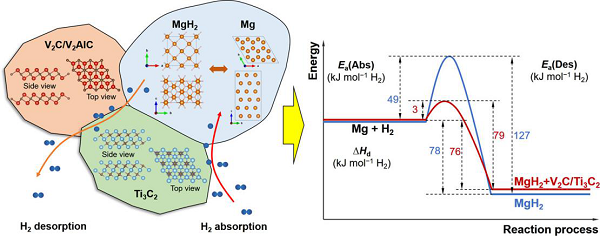
References: LIU, Haizhen, et al. Combinations of V2C and Ti3C2 MXenes for Boosting the Hydrogen Storage Performances of MgH2. ACS Applied Materials & Interfaces, 2021.
1. Jun Yan from Harbin Engineering University Adv. Funct. Mater.: Three-dimensional porous MXene/graphene antioxidant structure for in-situ zinc template preparation of high-performance supercapacitors
Two-dimensional transition metal carbides and nitrides (also known as MXene) endow MXene with a lot of fascinating properties due to its unique structure and tunable surface chemistry. MXene has huge application potential in the field of energy storage. However, similar to other two-dimensional materials, due to strong van der Waals forces, adjacent MXene interlayers inevitably undergo agglomeration and face-to-face re-stacking, which severely causes severe loss of electrochemically active sites and greatly limits the electrolyte ions. Therefore, dense MXene films generally exhibit low specific capacitance (100-300 F g-1) and poor rate performance, which still needs further improvement. In addition, MXene generally tends to gradually degrade in moist air, water, or under high temperature, hydrothermal and lytic heat conditions. In order to solve the above-mentioned huge challenges. The research group of Professor Jun Yan from Harbin Engineering University demonstrated an efficient and rapid strategy. Through the self-assembly method, metal zinc powder is used as an in-situ sacrificial template at room temperature, and then freeze-dried, thereby effectively inhibiting the possible occurrence of MXene. The surface is oxidized, and a 3D porous antioxidant MXene/graphene (PMG) structure is constructed. MXene and RGO nanosheets are cross-linked to form a three-dimensional porous structure, which is induced by Zn2+ as a cross-linking agent and zinc powder as an in-situ sacrificial template and reducing agent. This unique structure endows the 3D PMG composite with super electrochemical performance as a supercapacitor electrode, such as an intriguing specific capacitance (393 F g-1 at 2 mV s-1) and unparalleled rate performance (10 V s-1). -1 is 32.7%), and impressive cycle stability. In addition, due to the removal of oxygen-containing terminal groups and the cross-linking between MXene and graphene nanosheets as a shielding agent, 3D PMG composites also show significant oxidation resistance.

References: Yang X, Wang Q, Zhu K, et al. 3D Porous Oxidation-Resistant MXene/Graphene Architectures Induced by In Situ Zinc Template toward High-Performance Supercapacitors[J]. Advanced Functional Materials, 2021: 2101087.
2. Peng Qiuming Adv. Funct. Mater. from Yanshan University: Lithium MXene derivative framework for wide-temperature lithium metal anode
Lithium has an extremely low redox overpotential (-3.04 V relative to a standard hydrogen electrode) and the highest theoretical specific capacity (3860 mAh g-1, which is more than 10 times that of graphite). It is a promising Li-O2 and The electrode material of Li-S battery, unfortunately, due to uncontrolled dendrite growth and infinite volume expansion, leading to short circuits and rupture of the SEI film. Professor Peng Qiuming of Yanshan University and others used the cross-linked network structure of MXene to provide fast electron/ion transmission channels and at the same time serve as a framework for uniform Li deposition. In the 3D framework, super photophilic materials can be introduced to transfer Li deposition to Keep away from the separator/negative electrode interface to prohibit the formation of Li dendrites. In addition, considering that temperature will significantly affect the characteristics of metal lithium batteries. For example, high temperature will easily volatilize the electrolyte and reduce battery cycle performance, while low temperature will reduce the mobility of lithium ions and accelerate the growth of dendrites. In this paper, a new type of 3D LiTiO2-Li3N-C hybrid anode prepared by the reaction of molten Li and MXene-derived TiO2/N-doped carbon has been realized for the first time for a stable lithium metal battery. The team proved that LiTiO2-Li3N-C is a hybrid negative electrode with a volume expansion close to zero during the stripping/plating process. At the same time, the Li3N formed during the melt manufacturing process acts as a super-photophilic intermediate phase, guiding Li deposition away from the separator/negative electrode interface. In addition, when the current density of LiTiO2-Li3N-C is 1 mA cm-2 at 25°C, it can provide 2000 hours of continuous electroplating/stripping cycle life in a symmetrical cell. More attractively, even at a high current density of 10 mA cm-2, the symmetrical battery can be cycled at -10°C and 50°C for 34 hours and 500 hours, respectively.

References: Wang J, Yang M, Zou G, et al. Lithiation MXene Derivative Skeletons for Wide-Temperature Lithium Metal Anodes[J]. Advanced Functional Materials, 2021: 2101180.
3. Fujian Normal University Li Xiaoju Adv. Mater.: Ion covalent organic nanosheets with electrostatic adsorption and catalysis realized on MXene, used as separators for lithium-sulfur batteries
Lithium-sulfur battery (Li-S) is considered to be an attractive energy storage system due to its high energy density and low cost. However, it has the most complex problems such as the shuttle effect of soluble polysulfides, which can lead to The capacity decays fast, the self-discharge is serious, the energy efficiency is low, and the cycle stability is poor. Using nanostructured materials as a sulfur host is a common method to alleviate the shuttle of polysulfides. Although great progress has been made in the design and synthesis of sulfur composite cathodes, it is still a huge challenge to achieve high energy density and ultra-long life under high sulfur content, high sulfur loading, and high speed. MXenes is a type of two-dimensional transition metal carbides/carbonitrides. Due to its high conductivity, amphiphilic and catalytic effects on polysulfides, it has broad application prospects in lithium-sulfur batteries. However, an insurmountable obstacle in MXene nanosheets is the re-stacking caused by van der Waals attraction and hydrogen bond interaction, which leads to a large loss of specific surface area and difficulty in obtaining high concentrations of polysulfides. One of the effective solutions is to combine MXenes with porous materials to form composite materials. Two-dimensional covalent organic frameworks (COFs) are an attractive class of porous materials composed of strong covalent bonds and periodic structural units. The unique structure of COFs brings huge advantages to the adsorption and mass transfer of polysulfides. However, so far there is no report on the use of MXene and ionic polymer composite materials for Li-S batteries. The research group of Professor Li Xiaoju from Fujian Normal University proposed a new strategy to modify polypropylene diaphragms by using the electrostatic adsorption and catalysis of polysulfides. The guanidine-based covalent organic nanosheets (iCON) on the surface of Ti3C2 are used as the coating of the PP separator. The synergistic effect of Ti3C2 and iCON provides a new platform for inhibiting the shuttle effect of polysulfides, accelerating the redox kinetics of sulfur species, and promoting the efficient conversion of intercepted polysulfides. The functional separator imparts excellent electrochemical performance to the carbon nanotube/sulfur cathode. At 2°C, the average capacity attenuation per cycle within 2000 cycles is as low as 0.006%. When the sulfur content is 90 wt% and the sulfur content is 7.6 mg cm-2, the membrane can still effectively separate; the reversible capacity, area capacity and volume capacity at 0.1 C reach 1186 mA hg-1, 9.01 mA h cm-2 and 1201 mA h cm-3. This work provides a promising method for reforming the diaphragm for the development of high-performance Li-S batteries.

References: Li P, Lv H, Li Z, et al. The Electrostatic Attraction and Catalytic Effect Enabled by Ionic-Covalent Organic Nanosheets on MXene for Separator Modification of Lithium-Sulfur Batteries[J]. Advanced Materials, 2021: 2007803.
4. Xiao Zhubing Small, Henan University: CNTs grown on MXene induced by Ostwald maturation between layers are used for lithium-sulfur batteries
Transition metal carbides, carbonitrides and nitrides (MXenes) have extremely high metal conductivity, hydrophilicity, catalytic activity and excellent mechanical properties, making them become energy storage electrode materials or electrocatalysts such as water decomposition and N2 fixation Rising stars in the field. Despite these advantages, layered MXenes tend to restack themselves due to hydrogen bonds or van der Waals interactions between the layers, which results in a substantial reduction in surface area and hinders ion transfer and electrolyte penetration. In recent years, the hybridization of MXene with some inorganic materials is considered an effective strategy. MXene substrate can inhibit the agglomeration of attached particles and buffer the mechanical stress imposed on them. The attached particles act as a wedge, reducing the re-stacking of adjacent MXene layers, thereby maximizing the exposure of active sites and allowing ion transfer It is smoother and allows electrolyte to penetrate. However, most of the attached particles used in the reported solutions are metal oxides and sulfides, which usually have poor Li+ diffusivity and conductivity, which brings some adverse effects: 1) These low-conductivity particles are incompatible with After the hybridization of MXenes, heterogeneous grain boundaries and gap junctions are inevitably formed, which increases the interlayer charge transfer resistance of the MXene layer, thereby hindering the electron transfer along the vertical direction. 2) Due to the harsh preparation conditions, most of the MXenes in the hybrid product exhibit a higher degree of oxidation than the Mn+1XnTx precursor, which destroys the special properties such as metal conductivity attached to its structure. Therefore, it is of great significance to explore highly conductive inorganic-nano-MXenes hybrid materials with high integrity, rich active sites, rich and well-distributed nanopores. The research group of Professor Xiao Zhubing of Henan University reported that the in-situ Ti3C2Tx MXene-carbon nanotubes (Ti3C2Tx-CNTs) hybrids were generated by the low-temperature autocatalytic growth of CNTs on Ti3C2Tx nanosheets without adding any catalyst precursors.化物. Combining the results of spectroscopic studies and theoretical calculations, it is confirmed that the Ti3C2Tx nano-network structure induced by Ostwald maturation in the layer helps the ultrafine metal Ti catalyst to be uniformly precipitated on Ti3C2Tx, thereby forming high integrity in-situ CNTs on the Ti3C2Tx surface. Ti3C2Tx-CNTs hybrid material has the advantages of affinity electrolyte penetration, barrier-free three-dimensional Li+/e transport, and abundant electroactive sites, which proves that Ti3C2Tx-CNTs hybrid is a high-load lithium-sulfur battery to accommodate sulfur and regulate more Ideal 3D scaffold for sulfide conversion.

Reference: Xu M, Liang L, Qi J, et al. Intralayered Ostwald Ripening-Induced Self-Catalyzed Growth of CNTs on MXene for Robust Lithium-Sulfur Batteries[J]. Small, 2021: 2007446.
5. Jida Han Wei and Shen Guozhen, Institute of Semiconductors, Chinese Academy of Sciences Adv. Funct. Mater.: Controllable assembly of MXene nanosheets as electrodes and active layers for high-performance electronic skin
MXene has excellent electrical conductivity, mechanical flexibility and water dispersibility, rich chemical composition, adjustable surface termination and controllable preparation process, and is widely used in flexible electronic products. The application of electronic skins with high sensitivity, portability and foldability in artificial intelligence, human-computer interaction, health monitoring, soft robots and disease detection has received great attention. The flexible pressure sensor is generally composed of a flexible substrate, an active layer and conductive electrodes. The basic requirements for the development of this sensor are considerable bending strain capacity, high sensitivity, low drive voltage, fast response time and excellent stability. The structure and morphology of the active layer are considered to be the key factors to improve the pressure-sensitive response of flexible devices. This electrode must be compatible with the sensing film during the bending cycle and maintain its high conductivity. Professor Wei Han of Jilin University and the team of Guozhen Shen from the Institute of Semiconductors of the Chinese Academy of Sciences successfully fabricated a high-performance flexible pressure sensor based on MXene/PAN composite film with uniform Ti3C2Tx MXene electrodes. This flexible device has excellent pressure sensing performance and stability against mechanical bending. It also has a low detection limit of 1.5Pa and a fast response time of 30 ms. The sensitivity of this sensor is ≈2-20 times higher than similar sensors using traditional Ni, Cu, Au or Ag electrodes. In addition, the flexible pressure sensor based on MXene@PAN we made successfully detected human life activities such as pulses and sound signals, confirming its broad application prospects.

References: Fu X, Wang L, Zhao L, et al. Controlled Assembly of MXene Nanosheets as an Electrode and Active Layer for High-Performance Electronic Skin[J]. Advanced Functional Materials, 2021: 2010533.
6. Wu Mingbo, China University of Petroleum Adv. Funct. Mater.: Improve pseudocapacitance and high-load lithium/sodium storage by bonding polyoxometalate nanoparticles on MXene nanosheets
Hybrid supercapacitors combine the advantages of metal ion batteries and supercapacitors, and represent promising power sources for many current and emerging applications. Under normal circumstances, hybrid supercapacitors use the anode of a lithium-ion battery or sodium-ion battery as an energy source, and the cathode of a supercapacitor as an energy storage device. Since the anode and the cathode involve different working mechanisms, the key to promoting the practical performance of hybrid supercapacitors is to coordinate these two different electrodes reasonably. The battery type negative electrode uses a slow ion diffusion process for energy storage, while the capacitive type positive electrode stores charge through rapid surface adsorption/desorption. To fully tap the potential of hybrid supercapacitors, the imbalance between these two electrodes must be resolved. Kinetic issues. Therefore, there is an urgent need for battery-type electrode materials that have multiple electrons participating in the redox reaction and can quickly transfer lithium/sodium ions. To this end, a feasible solution is to form a stable connection between the redox active sites of lithium/sodium storage and the conductive substrate that promotes charge transfer. The research group of Professor Mingbo Wu from China University of Petroleum reported that through rational use of their interactions, dense and uniformly dispersed Mo and Fe-based POM (MF POM) nanoparticles were grown in situ on MXene (Ti3C2X) nanosheets, thereby achieving high speed Capacity of lithium/sodium storage. Ti3C2X nanosheets can realize effective electron transfer due to their metal conductivity, while POM nanoparticles prohibit their strong re-stacking tendency. The synergy between these two components enables lithium/sodium energy storage to exhibit high specific capacity, high magnification and excellent stability even under high-quality loads. Based on the electrode material, lithium ion capacitors (LIC) and sodium ion capacitors (SIC) are manufactured, which have high energy density, high power capability and excellent cycle stability.

References: Chao H, Qin H, Zhang M, et al. Boosting the Pseudocapacitive and High Mass-Loaded Lithium/Sodium Storage through Bonding Polyoxometalate Nanoparticles on MXene Nanosheets[J]. Advanced Functional Materials, 2021: 2007636.
7. Han Suting Adv. Funct. Mater. of Shenzhen University: MXene-ZnO memristor for multi-modal sensor calculation
The development of the Internet of Things and artificial intelligence has induced the rapid growth of sensor nodes, resulting in a large amount of unstructured redundant raw data. In traditional designs, analog sensor data is first converted into digital data through analog-to-digital conversion, and then stored in a memory unit. The calculation task is further completed by transmitting digital data between the memory and the local computing unit. The separate architecture of the sensor, memory, and data processing unit leads to data acquisition delay and relatively high power consumption. Therefore, some people propose to directly process information in-sensor calculations through a single sensor or multiple connected sensors to improve the energy, area, and time efficiency of the artificial intelligence system. Current research is mainly focused on single sensory processing, such as hearing, vision, touch, smell and so on. The human perception system can simultaneously perceive and process complex environments and process different types of information. Therefore, there is an urgent need to explore a smart device with light and proton-related signal processing functions to imitate the adaptive behavior of the human eye in different environments. MXene is a new family of two-dimensional transition metal carbonitrides, carbides and nitrides. Due to its solution processability and intriguing physical and chemical properties, it has become a promising two-dimensional in many fields such as energy conversion and storage. material. The research group of Professor Han Suting of Shenzhen University demonstrated the calculation of multi-modal internal sensors based on flexible membrane resistance units. Each unit is composed of MXene nanosheets/ZnO nanoparticles (NPs) heterogeneously. The combination of metal MXene and semiconductor ZnO NPs can ensure the proper resistance state of the memristor. In addition, Ti3C2 terminated with OH bond has high hydrophilicity and can be combined with photoactive ZnO NPs. The resistance switching characteristics can be modulated by changing light intensity or humidity. The proton/photon-mediated plasticity allows the memory resistance crossbar to light/ Proton sensing is combined with neuromorphic computing. In sensor calculations, MXene-ZnO memristors are used as filters to preprocess information and synapses to achieve a weight update process with different humidity adaptability. Multi-modal calculations within the sensor provide the potential to reduce the potential circuit complexity of traditional neuromorphic vision systems and contribute to the development of intelligence at the device level.

Reference: Wang, Yan, et al. MXene-ZnO Memristor for Multimodal In-Sensor Computing. Advanced Functional Materials (2021): 2100144.
8. Beijing University of Chemical Technology Wan Pengbo ACS Nano: Healable, degradable, conductive MXene nanocomposite hydrogel is used for multifunctional epidermal sensors
As a next-generation flexible epidermal sensor material, conductive hydrogel converts physiological activity signals into detectable electronic signals by virtue of its good flexibility and high sensitivity for information acquisition, which has attracted more and more attention. However, the existing conductive hydrogel has poor mechanical properties and is inevitably damaged during the stretching process, which seriously hinders its practical application in flexible skin sensors. At the same time, compared with traditional hydrogel-based sensors to monitor various human movements, the detection of electrophysiological signals such as electromyography (EMG) and electrocardiogram (ECG) signals is of great significance to the diagnosis and treatment of heart and muscle-related diseases. Therefore, there is an urgent need to develop conductive hydrogel-based epidermal sensors with autonomous self-healing capabilities and environmental degradation capabilities to detect human physiological and electrophysiological signals. As a transition metal carbide, nitride or carbonitride, MXenes has broad application prospects in the fields of electromagnetic interference shielding, catalysts and electrochemical energy storage. With abundant surface functional groups (-OH, -F, -O, etc.), large specific surface area and high conductivity, it is expected to improve the mechanical properties and conductivity of hydrogel-based epidermal sensors. Researcher Wan Pengbo of Beijing University of Chemical Technology proposed a synthesis strategy for a multifunctional epidermal sensor based on a highly stretchable, self-healing, degradable, and biocompatible nanocomposite hydrogel. The composite hydrogel is manufactured by conformally coating the MXene (Ti3C2Tx) network on a hydrogel polymer network composed of polyacrylic acid and amorphous calcium carbonate. The epidermal sensor can be used to sensitively detect human movement, has a fast response time (20ms), and can be used as an electronic skin for wireless monitoring of electrophysiological signals (such as electromyogram and electrocardiogram signals). At the same time, the multifunctional epidermal sensor can be degraded in a phosphate buffered saline solution without causing pollution to the environment. Research work in this field provides clues for the manufacture of conductive hydrogel skin sensors that are healing, degradable, and sensitive to electrophysiological signals. These sensors have potential applications in human-computer interaction, health diagnosis, and intelligent robotic prosthetic devices. .

References: LI, Xiaobin, et al. Healable, Degradable, and Conductive MXene Nanocomposite Hydrogel for Multifunctional Epidermal Sensors. ACS nano, 2021.
9. Jida Han Wei and Wang Lili of the Institute of Semiconductors of Chinese Science and Technology ACS Nano: Carbon-reinforced Nb2CTx MXene/MoS2 nanosheets as high-rate and high-capacity anodes for sodium-ion batteries
Among metal sulfides, MoS2 has attracted much attention due to its high energy density and layered structure. The interlayer van der Waals attractive force of MoS2 is relatively weak, so it has a higher specific surface area and a larger ion intercalation interval. MoS2 has a high theoretical capacity and excellent performance in lithium ion batteries, but due to the larger sodium ion radius (compared with lithium ion radius), the volume expansion caused by sodium insertion is more severe, so it is used in sodium ion batteries There are still problems such as low capacity and poor cycle stability.
Compared with MoS2, Nb2CTx has a lower sodium diffusion barrier, excellent electrical conductivity and more surface functional groups. Therefore, Nb2CTx is a potential negative electrode material for sodium ion batteries. Professor Han Wei from Jilin University and Professor Wang Lili from the Institute of Semiconductors of the Chinese Academy of Sciences and others developed carbon-coated Nb2CTx MXene framework MoS2 nanosheets (Nb2CTx@MoS2@C) and constructed a solid three-dimensional cross-linked structure. In such a design, the highly conductive Nb2CTx MXene nanosheets can prevent the re-stacking of MoS2 sheets and provide effective channels for charge transfer and diffusion. In addition, the layered carbon coating has a certain volume elasticity and excellent electrical conductivity, which ensures the insertion of sodium ions, which is not only conducive to rapid dynamics, but also conducive to long-term stability. Nb2CTx@MoS2@C negative electrode can provide an ultra-high reversible capacity of 530 mA h g-1 under the condition of 0.1 A g-1 after 200 cycles, and under the condition of 1.0 A g-1, it can be used for 2000 times In the cycle, the capacity is 403 mA h g-1, and the degradation rate per cycle is only 0.01%, which has a very long cycle stability. In addition, in terms of rate performance, the capacity retention rate of this negative electrode from 0.1 to 1 A g-1 is about 88.4%. The most important thing is that the Nb2CTx@MoS2@C negative electrode can achieve rapid charge and discharge at a current density of 20 or even 40 A g-1, with capacities of 340 and 260 mAh g-1, respectively, which will increase the number of sodium-ion batteries in practical applications .

References: YUAN, Zeyu, et al. Carbon-Reinforced Nb2CTx MXene/MoS2 Nanosheets as a Superior Rate and High-Capacity Anode for Sodium-Ion Batteries. ACS nano, 2021.
10. Lv Shaoyu, Lanzhou University, ACS Appl. Mater. Interfaces: Super-stretched MXene composite hydrogel as a two-way stress-responsive thixotropic sensor
The development and application of biological intelligent sensing technology has penetrated into our lives. However, problems such as low mechanical properties, inflexible signal transmission, and insensitive signal output limit the development of biosensors. In order to solve these problems, the hydrogel-based biosensor has been designed and developed due to its excellent soft stretch performance, special conductive framework and complex 3D ion channels. Because of its unique high electron mobility and inter-chip energy storage characteristics, MXene expands the development and application prospects of conductive hydrogels as biosensors. MXene nanocomposite organic hydrogel can perform 350% strain sensing at low temperatures. However, the previously reported MXene composite conductive hydrogel, due to its insufficient mechanical properties, causes the sensing tensile strain to not exceed 1000%. After large strain, the hydrogel cannot recover or maintain its original shape, even if it has a large strain sensing capability. It is also impossible to realize dynamic sensing under small local concentrated stress stimulation, which limits the application of MXene composite hydrogel as a flexible sensor. Professor Lu Shaoyu’s research group from Lanzhou University has developed a super-stretched MXene composite conductive hydrogel with a tensile strain of more than 1800%. The hydrogel is used as a flexible wearable sensor to detect human motion signals in real time. The sensor achieves high sensitivity and can distinguish human body movements in multiple directions, such as joint bending, throat vocalization, swallowing, and pulse beating. In addition, it is observed that the MXene composite hydrogel has rapid resilience after unloading the reverse compressive stress, and can quickly generate a specific current response in the low pressure area without leaving any traces. This thixotropic sensor realizes a rapid response to two-way stress, and has huge application prospects in the fields of human motion detection and national defense information encryption.

References: CHEN, Siqi, et al. Superstretching MXene Composite Hydrogel as a Bidirectional Stress Response Thixotropic Sensor. ACS Applied Materials & Interfaces, 2021.
11. ACS Appl. Mater. Interfaces: Hydroxyl promoted nitrogen reduction reaction: the important role of surface hydrogen in functionalized MXenes
Ammonia (NH3) is an important industrial raw material widely used in the production of fertilizers, refrigerants and other chemicals. Electrochemical Nitrogen Reduction Reaction (NRR) is a promising technology to replace the Haber-Bosch process (HBP). Through the reaction of N2 and H2O, green NH3 can be generated at room temperature. The core of this process is to find an effective catalyst that can improve the activity and selectivity of NRR, which is still a huge challenge. 2D MXenes have been extensively studied for electrocatalytic NRR due to the advantages of exposed active sites and high conductivity. At the same time, some theoretical studies have shown that MXenes without terminal groups can effectively activate N2 and catalyze NRR. However, the exposed surface of MXenes is very active, because exposed metal atoms tend to terminate with changes in applied potential and pH. Therefore, the previous NRR research based on naked MXenes is debatable. It is necessary to re-study the functionalized MXenes and explore new reaction mechanisms to clarify the actual catalytic process and track the missing chemical components. Professor Thomas Frauenheim of the University of Bremen in Germany and Professor Liangzhi Kou of the Queensland University of Technology in Australia studied several MXenes (Ti2C, V2C, Cr2C, Zr2C, Nb2C, Mo2C, Hf2C, Ta2C) Priority structure under NRR operating conditions. The results show that OH, as a new surface hydroxylation mechanism, plays an important role in NRR chemical regulation. In the widely accepted NRR mechanism, only protons participate in the reaction Differently, the hydrogen (H) atoms of the surface hydroxyl groups can be captured by the intermediate and participate in the NRR reaction, while the remaining H vacancies can then be self-repaired by protons under the applied potential. The synergistic effect of surface hydroxylation can effectively increase NRR, and Mo2C(OH)2 stands out with a limit potential of -0.62 V and the highest selectivity. In addition, a new scale relationship based on the H vacancy energy was established to clarify the possibility of structure-activity regulation. The study not only explained the important role of surface OH functionalization in evaluating the performance of NRR, but also provided new insights for promoting the sustainable production of NH3.

References: LV, Xingshuai; KOU, Liangzhi; FRAUENHEIM, Thomas. Hydroxyl-Boosted Nitrogen Reduction Reaction: The Essential Role of Surface Hydrogen in Functionalized MXenes. ACS Applied Materials & Interfaces, 2021.
12. Wang Xinhua of Zhejiang University and ACS Appl. Mater. Interfaces in Liuhai Town of Guangxi University: The combination of V2C and Ti3C2 MXenes improves the hydrogen storage performance of MgH2
Magnesium hydroxide (MgH2) has a high hydrogen density (7.6 wt %) and good reversibility, making it an ideal hydrogen storage material. However, its high thermal stability and slow kinetics severely limit its practical application. Two-dimensional transition metal carbides/nitrides (MXenes) and their derivatives also have a positive impact on hydrogen storage materials due to their special physical and chemical properties. Professor Wang Xinhua of Zhejiang University and Assistant Professor Liu Haizhen of Guangxi University synthesized 2D vanadium carbide (V2C) and titanium carbide (Ti3C2) MXenes by stripping V2AlC or Ti3AlC2, and introduced them into magnesium hydroxide (MgH2) to adjust MgH2 The hydrogen desorption/absorption performance. The prepared MgH2-V2C-Ti3C2 composite material has better hydrogen storage performance than pure MgH2. It adds 10 wt% of 2V2C/Ti3C2 to MgH2. Compared with adding only V2C or Ti3C2, the combination of V2C and Ti3C2 promotes the hydrogen release process of MgH2, and in the hydrogen absorption process of MgH2 at room temperature, Ti3C2 has a strong The impact is more significant than V2C. They proposed the following possible mechanisms for the release and absorption of hydrogen in the MgH2-V2C-Ti3C2 system: during the desorption process, hydrogen atoms or molecules may preferentially transfer through the MgH2/V2C/Ti3C2 three grain boundaries, and during the absorption process, hydrogen atoms or molecules may have priority Transfer through the Mg/Ti3C2 interface. Microstructure studies show that V2C and Ti3C2 are mainly high-efficiency catalysts for MgH2. This work conducted an in-depth study on the combination of two MXenes to promote the hydrogen storage behavior and mechanism of MgH2.

References: LIU, Haizhen, et al. Combinations of V2C and Ti3C2 MXenes for Boosting the Hydrogen Storage Performances of MgH2. ACS Applied Materials & Interfaces, 2021.
- Previous: Science Advances: a bi
- Next: MXene breakthrough: Na


 mxene academic
mxene academic
